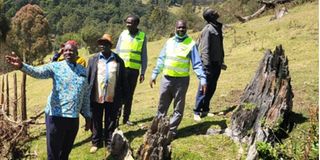'Marshall Plan' to get more water to fast-growing Eldoret

Eldoret Water and Sanitation company Managing Director Peter Biwott (in a floral shirt) at Tirich village in Elgeyo Marakwet County assessing the extent of the destruction of the Cherangany water tower.
The demand for water is growing in Eldoret, Uasin Gishu County, with a daily deficit of 17 million litres.
The shortage is partly blamed on the dwindling forest cover in the region, especially in the town’s crucial water catchment areas.
And now, the Eldoret Water and Sanitation Company (Eldowas) has embarked on an environmental reclamation programme to restore degraded areas.
The company plans to plant one million trees in each of its water catchment areas by encouraging people living around them to embrace the use of biogas and minimise wood fuel use, the main cause of forest depletion.
Eldowas Managing Director Peter Biwott said indigenous tree seedlings will be planted in the Cherangany hills water towers and the Kapseret and Kaptagat forests.
“The negative impact of human activity on our environments is being demonstrated by the diminishing water levels in our catchment areas,” he said.
He said they will co-opt schools, government agencies and the private sector in the programme.
“Other partners include the Kenya Forest Service, the National Environment Management Authority, local communities living around the water catchment areas and water courses, non-governmental organisations, community-based groups, as well as other agencies involved in environmental conservation activities.”
Eldoret is among Kenya’s fastest-growing towns and is poised to become the fifth city, but the sustained depletion of its ecosystem may delay the aspiration due to water scarcity.
Mobilising resources
The North Rift town requires an estimated 60 million litres of water per day against the current production of 43 million.
According to the 2019 Kenya Population and Housing Census, Eldoret, with 475,716 residents, is the fifth most populated urban area after Nairobi, Mombasa, Nakuru and Ruiru.
“If we fail to protect and conserve our environment, not only do we put our livelihoods at serious risk of decimation, but we endanger the survival of future generations as well,” Mr Biwott said.
He said the company will soon ink a Sh334 million deal with Nature Kenya that will help in rehabilitating catchment areas in Elgeyo Marakwet, Uasin Gishu and Nandi counties.
“We will continue mobilising resources for a sustainable conservation drive through collaboration with communities to enhance their participation and protection of the environment,” he said when he toured the Cherangany hills.
The Kerio, Nzoia and Turkwel rivers originate in the Cherangany hills.
Mr John Chesewes, of Tirich village, said the source of the multiple rivers that drain into Lake Victoria has been receding in volume because of the wanton destruction of the forests.
“Over the past two decades, trees have been cleared at an alarming rate and the water sources in the Cherangany water tower could dry up without massive reforestation,” he said.
“Unchecked human activities and overgrazing have led to soil erosion and siltation of the water bodies.”





